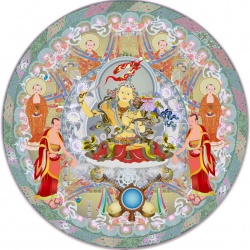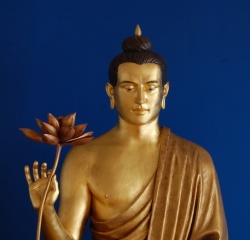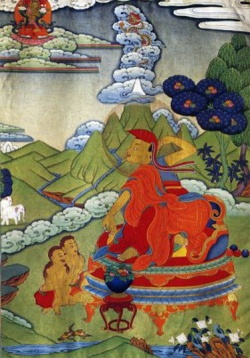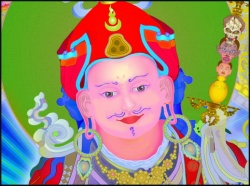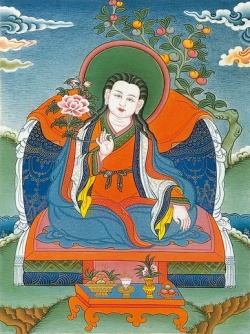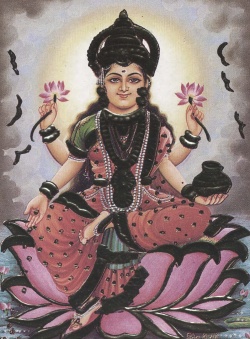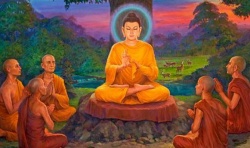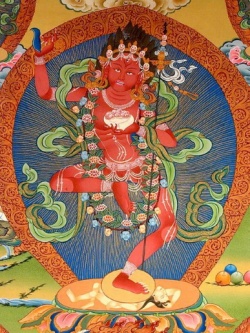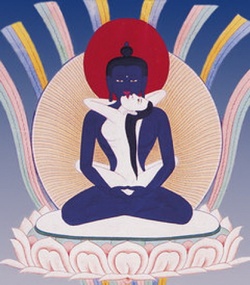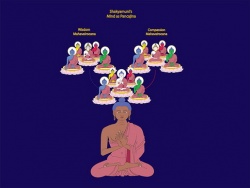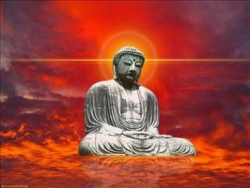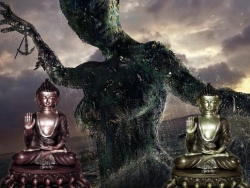Digha Nikaya, Sutta 33: The Compilation. Threes
Digha Nikaya
Sutta 33
Saṅgīti-Suttanta
The Compilation
Threes
Translated from the Pali by Michael Olds
There are, friends, three-part Dhammas consummately taught by the Bhagava, that #1-Consummately-Awakened-One, an Arahant who knows and sees. In this situation, let us allgather together as one, undivided, so that this Best of Lives will stay on track and stand for a long time as a benefit to the many, as a pleasure for the many, out of compassion for the world, for the benefit and pleasure of gods and man. What are these threes?
Three Roots of Unskill: lust, hate and stupidity
Three Roots of Skill: non-lust, non-hate and non-stupidity.
Three Modes of poor behavior: bodily, of speech, of mind.
Three Modes of good behavior: bodily, of speech, of mind.
Three unskillful subjects of thought: on pleasure, on anger, on harming.
Three skillful subjects of thought: on giving up, on non-anger, on non-harm.
Three unskillful principles[1]: the pleasure-principle, the anger-principle, the harm-principle
Three skillful principles: the giving-up principle, the non-anger principle, the non-harm principle
Three unskillful perceptions: the pleasure-perception, the anger-perception, the harm-perception
Three skillful perceptions: the giving-up perception, the non-anger perception, the non-harm perception
Three unskillful elements: the pleasure-element, the anger-element, the harm-element
Three skillful elements: the giving-up element, the non-anger element, the non-harm element
Three additional elements: the pleasure-element, the materiality-element, the immateriality-element[2]
Three additional elements: the materiality-element, the immateriality-element, the ending-element
Three additional elements: the inferior-element, the middle-element, the superior-element[3]
Three Modes of Hunger/Thirst: for pleasure, for living, for un-living[4]
Three additional hungers: for pleasure, for materiality, for immateriality
Three additional hungers: for materiality, for immateriality, for ending[5]
Three yokes to rebirth[6] One-truth-view, vacillation, faith in good deeds and ethical conduct.
Three corruptions[7]: No-good pleasures, no-good living, no-good blindness
Three livings: pleasure-living, material-living, immaterial-living.
Three wishes[8]: for pleasure, for life, for the full glory of the holy life
Three evaluations[9] the evaluation that "I am better than," the evaluation that "I am equal to," the evaluation that "I am less than."
Three whiles: back-awhile, up ahead a-while, mean-while.[10]
Three oppositions[11]: the opposition to own body; the opposition to the arising of own body; the opposition to the ending of own body.
Three sense experiences: pleasant sense experience, unpleasant sense experience, not-unpleasant-but-not-pleasant sense experience[12]
Three types of pain: The pain of pain; the pain of the confounded; the pain of reversal[13]
Three piles[14]: certainly disagreeable piles; certainly consummate piles; uncertain piles.
Three confusions[15]: The onset of and lingering confusion, doubt, inability to clear up one's mind and distress about the past. The onset of and lingering confusion, doubt, inability to clear up one's mind and distress about the future. The onset of and lingering confusion, doubt, inability to clear up one's mind and distress about the present.
Three unguarded things of a Tathagata. A Tathagatha, friends is entirely pure with regard to that done by the body, such that he need not think: "Let none know this of me." A Tathagata, friends, is entirely pure with regard to that done by way of speech, such that he need not think: "Let none know this of me." A Tathagata, friends, is entirely pure with regard to that done by way of mind, such that he need not think: "Let none know this of me."[16]
Three Somethings-There[17]: Lust, Hate, Delusion
Three Fires: Lust, Hate, Delusion
Three additional Fires: the fire of the honor-worthy, the fire of the householder, the fire of the gift-worthy[18]
Three Forms of Matter (rupa): visible and producing resistance[19]; not visible and producing resistance; not visible and not producing resistance
Three Confoundings:[20] good; not-good; inactive.
Three persons: the person who is a seeker[21], the person who is a seer, the person who is neither seeker nor seer.
Three elders: by birth, in the Dhamma, by rank[22]
Three bases for the expectation of benefit, the expectation of benefit based on making gifts, the expectation of benefit based on ethical behavior and the expectation of benefit based on self-improvement[23]
Three bases for making testimony: based on the seen, based on the heard, based on the suspected.[24]
Three ways of taking carnal enjoyment:[25] There are beings, friends, to whom carnal enjoyments appear and who are bound up in and in the power of the carnal enjoyments that appear to them in the same way as man, for example, or gods for another, or some reborn below. This is the first way of taking carnal enjoyment. There are beings, friends, taking carnal enjoyment in plans and creations and who are bound up in and in the power of the carnal enjoyment of making creation upon creation in the same way as are The Gods of Creation. This is the second way of taking carnal enjoyment. There are beings, friends, taking carnal enjoyment in having power over plans and creations and who are bound up in and in the power of the carnal enjoyment of having power over plans and creations in the same way as are The Gods of Power Over Creation. This is the third way of taking carnal enjoyment.
Three ways of feeling pleasure:[26] There are beings, friends, that, producing and having produced pleasure, live therein, in the same way as the gods of the Brahma worlds. There are beings, friends, that are soaked, permeated, suffused and saturated with happiness who time and time again exclaim: 'Ah the joy! Ah the joy!" in the same way as the gods of the Abhassara Realm. There are beings, friends, that are soaked, permeated, suffused and saturated with happiness who are swept away by the experience of such delight in the same way as the gods of the Subhakinna Realm.
Three wisdoms: The seeker's wisdom. The seer's wisdom. The wisdom of one who is neither.
Three additional wisdoms: Wisdom based on reason. Wisdom based on hearsay. Wisdom based on experience.[27]
Three weapons[28]: the weapon of knowledge, the weapon of detachment, the weapon of wisdom.
Three Guiding Forces[29]: The Guiding Force that is knowing the unknown; The Guiding Force of Omnicience; The Guiding Force of Attaining Omnicience.
Three Eyes[30]: The organ of the eye; the godly eye; the eye of wisdom.
Three trainings[31]: training in higher ethics, training in higher thought, training in higher wisdom.
Three Developments[32]: Development of Body, Development of Mind, Development of Wisdom
Three ultimates[33]: The ultimate sight, the ultimate undertaking, the ultimate freedom.
Three Highs[34]: With Thought and with Reaction; Without Thought and with only a small amount of Reaction; Without Thought and without reaction
Three additional Highs[35]: Empty, Signless, Pointless.
Three cleansings[36]: cleansing the body, cleansing the speech, cleansing the mind.
Three attributes of the wiseman[37]: the body of a wiseman, the speech of a wiseman, the mind of a wiseman.
Three attributes of the skilled[38]: skill at arriving, skill at departing, skill in knowhow
Three forms of madness[39]: The madness of health, the madness of youth, the madness of life.
Three controlers[40]: self-control, peer-pressure, the influence of The Word
Three areas of dispute[41]: There is the area of dispute over the past that begins: 'Thus it was in the past.' There is the area of dispute over the future that begins: 'Thus it will be in the future.' There is the area of dispute over the present that begins: 'This is how it is now.'
Three visions[42]: knowledge of past lives; knowledge of the outcome of deeds; knowledge of the eradication of the asavas
Three habitats[43]: the habitat of the gods, the habitat of Brahma, the habitat of the Aristocrats.
Three wonders[44]: the wonders of magic power, the wonders of mindreading, the wonders of teaching
These then, friends, are those three-part Dhammas consummately taught by the Bhagava, that #1-Consummately-Awakened-One, an Arahant who knows and sees. In this situation, let us all gather to gether as one, undivided, so that this Best of Lives will stay on track and stand for a long time as a benefit to the many, as a pleasure for the many, out of compassion for the world, for the benefit and pleasure of gods and man.
Footnotes
[1] X-saŋkappā, X-saññā X-dhātu. I think in this set of six sets of terms we are being given a look-see into a very deep and not at all usual way of seeing the world. Starting with perceptions, our ordinary way is to think of ourselves as passive recipients of perception. Ordinarily we think of skill with regard to perception as "one has accurate or inaccurate perceptions and the more accurate the more skillful." But here we are being asked to understand that to have a perception of a certain nature is either skillful or unskillful. In other words, we are being told that perception is a matter of intent. There is the case (see: The Powers of the Aristocrats) where perception is a matter of will: "...he is able to wish: 'let me perceive the ugly in the beautiful, the beautiful in the ugly, etc." And this would also fit in with the understanding of the transmutation of vedana depending on one's mental set with regard to being a part of the world (see discussion at dhamma_talk/feelings. Then, if perception is a matter of will or intent, it is not too difficult to see that there must be available to the perceiver at the outset both skillful and unskillful elements from which to choose, so that is covered. From there we can understand that sankappas (my "principles" others "aims" or more broadly, our intents, priorities and purposes based on our point of view) direct the mind towards skillful or unskillful elements which when contacted by sense-organ will produce skillful or unskillful perceptions. One more thing to factor in: The giving up element / principle / perception. Given that perception is based on elements, elements are necessarily finite. The finite exists within the infinite and therefore there would need to be an element which represented the interface (or it would be like one was either locked onto the infinite or the finite and could not escape...there needs to be an element that allows for detachment...I imagine a set of wires connected to a bomb; one can choose wires that produce a friendly explosion or ones that choose an unfriendly explosion, or the one that defuses the bomb.) The danger here is clear: one must at all costs avoid the conclusion that because one is able to direct perception and that consequently one's world is clearly of one's own making, that one therefore has a self somewhere in either the creative forces or the results. Well, I don't know about you, but this seems altogether a hugely revolutionary set of notions. I am reasonably sure there is nothing similar in Western psychology, and I don't think this idea appears in western philosophy. This should be world-shaking.
[2] (kāma, rūpa, arūpa) Walshe and Rhys Davids, probably following commentary, take these to be "realms" or "loka" with Rhys Davids even making out rupa to be the Brahma world and arupa to be the higher heavens (arupa-lokas). My position is that we should stick to what we find in the text and make the commentary fit if possible, which would allow for us to say that the Brahma world was rupa-element in nature but would allow for the idea that there were things other than the Brahma world which could be classed as of the rupa-element...etc.
[3] (hīnā, majjhimā, paṇītā) Walshe has: low, middling, sublime; Rhys Davids has: low, medium, sublime. hīnaŋ dhātuŋ paṭicca uppajjati hīnā saññā hina-element rebound bound-up-in hina perception. Hinayana = the lesser vehicle. Hina jati in formula for arahant, left behind is rebirth, or no more rebirth. Be-hind, hinder, rear, back, posterior. PED: hina: inferior, low; poor, miserable; vile, base, abject, contemptible, despicable paṇīta PED: 1. brought out or to, applied, executed; 2. brought out or forth (made) high, raised, exalted, lofty, excellent; with reference to food (very often used in this sense) "heaped up, plentiful, abundant." opp: hina. Fore- front
[4] (vibhava): since "vi" can mean "re-" "un-" "di-" "bi-" "dis-", and in some contexts "vibhava" is an indication of increase, (PED: 1. vibhava: power, wealth, prosperity) it is not absolutely certain that un-becoming, or ending or escape from living is the only real meaning intended in this context. In places where I have not claimed to be attempting a pure translation, I have used for the three thirsts: pleasure, living, more-living, re-living, and un-living. Not good translating, but acceptable Dhamma.
[5] Nirodha: While not conclusive evidence that vibhava should be understood as re-living or more-living, this is suggestive.
[6] Saŋyojanāni.) san=one's own; yoja=yoke; ja=birth; a=to; ni=down. See: The 10 Fundamental Attachments. Walshe and Rhys Davids: fetters. These are the things that "downbind" the individual to renewed birth, and it is the elimination of sets of these that define the stages in progress in the Pali system. The first three (sakkāya-diṭṭhi, vicikicchā, sīlabbata-parāmāso) when broken are the mark of stream-entry. Walshe has: personality-belief, doubt, attachment to rite and ritual; Rhys Davids: false opinion cerning individuality, doubt, inverted (judgment) as to rule and ritual, and notes: See Expositor i, 65. B.'s note on the first runs: belief in the actual existence of a kaya consisting in body and mind — i.e., of a soul (atta) in either of them. PED on sakkaya-ditthi: theory of soul, heresy of individuality, speculation as to the eternity or otherwise of one's own individuality. Being fettered to or yoked to one view of the self (sa=one >san=own; kaya=body) (and by extension of "the world") along with the holding that any other way of viewing the self is incorrect. See Glossology:Ditthi. Vicikiccha, doubt, vacilation; but specifically in the Pali, concerning kamma and the ability to escape kamma Where the translation for silabbataparamaso is usually given as belief in rites and rituals, I think this goes much further than that. Sila is ethical culture; silabbata is good works and ceremonial observances (so much richer than either rites or rituals); (paramasa is being attached to, in the sense of being under the influence of). It is holding on to the belief that these things, which can be good things in isolation, accomplish the liberation of the individual form samsara. They do not; they make good kamma or they are useless.
[7] (āavā) See: Glossology: Asava.
[8] (Esanā.) Walshe and Rhys Davids have: quests, PED: [from esati, to seek, search, strive for, indicating that this may have come from a confusion of the sounds from icchati, wish, but in the sense of incantation] desire, longing, wish.
[9] (vidhā) PED: 1. mode, manner, sort, kind; proportion, form variety; 2. (ethically) in special sense: a distinctive feature (of a person as different from others), a "mode" of pride or delusion, a "form" of conceit VI=di (split) dha=that; division, category. I don't see any justification in the simple word for the leap to "conceit" or "pride"; these may be divisions or types of pride or conceit, but that is an opinion about the nature of the set, not the meaning of vidha. seyyo, better; sadiso, similar, like, equal; hīno, inferior, less, worse.
[10] (addhā; atīto addhā, anāgato addhā, paccuppanno addhā) PED lists addhā only under addhan and has 1. a path, road, also journey, 2. (of time) a stretch of time, an interval of time, a period, also a lifetime. atīto: past, having gone; anāgato: not come yet, not got yet, i.e. the future; paccuppanno [paṭi+uppajjati, rebounded uprisen]: PED: what has arisen (just now), existing, present. Note the order. Throughtout the suttas this order is preserved. I suggest this is reflects the idea implicit in the paticca samuppada that the tendancy of the mind is to keep on rolling in the direction it is set rolling and here one does not persue the past or yearn for the future, but seeks liberation from the present. In addition, in the state of Timelessness (Akalika) which is attained by the Arahant or momentarily by others, Time as we know it does not exist. As you can imagine, this can lead to problems for one who has attained the state momentarily. Should they mistake their location and panic, this could lead to some unpleasant results. So this method of orientation is given, which, while describing Time on one level, describes situation on another.
[11] (antā; sakkāyo anto, sakkāyo-samudayo anto, sakkāyo-nirodho anto) antā: anti-, fore, (>antler) PED: [[[Wikipedia:Vedic|Vedic]] anta; Gothic andeis = Old High German. anti = English end; cp. also Latin antiae forehead (English antler), and the prep. anti opposite, antika near=Latin ante; Greek anti, anta opposite; Gothic, Anglosaxon and; German ant-; originally the opposite (i.e. what stands against or faces the starting-point)] 1. end, finish, goal; 2. limit, border; 3. side; 4. opposite side, opposite, counterpart; pl. parts, contrasts, extremes; thus also used as "constituent, principle" (in tayo ...or does it belong to anta2 in this meaning?). Anta2: 1. having an end, belonging to the end; only in negative ananta endless, infinite, boundless. Rhys Davids: limits; Walshe: ends This is an obscure category, for sure. If it were not for "ending of own body" as the third, "ending" would seem to be the interpretation closest to what we are used to expect from the suttas. Walshe sees this as the ending of the three views ("ending of personality (view)" etc., not as a reference to the ending of personality). Rhys Davids notes: 1. sakkayo: the five aggregates (body and mind) of grasping' comy; and 2. The discontinuance, extinction (nibbāna) of both.' comy. As I hear it, it is something like the way we set up resistance to ideas, so that the overall idea is that there are those that resist the idea of own body, there are those that resist the idea of the arising of own body, and there are those that resist the idea of the ending (extinction) of own body. The importance to Buddhists is that all three require point of view and that therefore resistance indicates (is a sign of) holding on to a view and should be got rid of. We do not hold the idea of "own body" or "personality", but we do not hold the idea of "there is no own body," etc.
[12] See The Third Lesson. Curious that this was not the first of the threes; and Glossology: Vedana
[13] (vipariṇāma re turn around; set-back. Walshe and Rhys Davids: change. I wonder if this, indicating re-birth, was not the older concept, with anicca in-constance coming after)
[14] (rāsī:) PED: 1. heap, quantity, mass; 2. (store of ) wealth, riches (MO: he made a pile) 3. a sign of the Zodiac (the 12 as given at Abhp 61 are: mesa, usabha, methuna, kakka.ta, sāha, ka~n~naa, tulaa, vicchikaa, dhanu, makara, kumbha, māna; or the ram, bull, twins, crab, lion, virgin, balance, scorpion, bow, capricorn, waterpot, fish (MO: and raasā?); 4. in logic: group, aggregate, category, congery freq. in Abhidhamma-literature where 3 "accumulations" are spoken of, viz. micchatta-niyato raasi, sammatta-niyato r., aniyato r. or "wrongdoing entailing immutable evil results, that of well-doing entailing immutable good results, and that of everything not so determined". . . In the 5 factors of individuality (body and mind) khandhā are explained as meaning raasā. micchatta-niyato rāsī[miccha=low, bad, contrary, opposite, opposed, opposite sammā) a wrong thing, in the Pali, a state opposing any of the 8/10 "folds" of the Magga; niyata PED: restrained, bound to, constrained to, sure (as to the future), fixed (in its consequences), certain, assured, necessary; sammatta-niyato rāsī high, consummate, best (again, of the 8/10 anghas of the Magga; aniyato rāsī not settled, uncertain, doubtful In the discussion groups on the web the term "accumulations" is thrown around very liberally, connected with all sorts of kamma, and with the implication that the predominant mode of kamma is the fixed sort. I think a very good case can be made that below the extra-ordinary level most deeds fall into the uncertain-outcome pile. The factor determining outcome of a deed in terms of experience is the intent with which the deed is performed. There are deeds which are of such high profile that it would be impossible to perform them with mixed intent. Of this sort, what we have in the literature is one or two extraordinary deeds described as fixed in outcome: the murder of one's parents or of an arahant, the drawing of the blood of a Tathagata with intent to injure, creating a schism in the Sangha; some extraordinary good deed done for the Buddha. For the rest it is just about as impossible to perform deeds without mixed intent. For a deed performed with mixed intent the outcome is determined by the point of view held at the time of fruitition (or earlier in the case of one able to recall deeds done long ago). The 'repayment' or 'balancing' of accounts is accomplished for deeds by experience of the sensations created in the original act. These sensations can be experienced over a lengthy period of time or instantaneously and subjectively valued as 'bad' or 'good' depending on the point of view held with regard to them. For example the experience of worry and anxiety connected with loss of wealth can be experienced as pleasant if the point of view taken is that this is a lesson in the perils of possession and the advantages of letting go and that the sensations are those of the ending of grasping after wealth. This is the lesson taught in the section of the Satipatthana connected with sensation where sensation is described as being of three sorts (painful, pleasant, and not-painful-but-not-pleasant] and of two modes [downbound to the world and not downbound to the world).
[15] (kankhā: confusion Atītaṃ vā: about the back/past addhānaṃ ārabbha kankhati vicikicchati nādhimuccati na sampasīdati: the onset of and lingering confusion, doubt, inability to make up one's mind, disequillibrium concerning the Anāgataṃ vā: about the ahead/future Etarahi vā paccuppannaṃ: about the now/present/meanwhile Walshe: obscurations: hesitation, vacillation is undecided is unsettled about the ... . Rhys Davids: doubts, perplexity, inability to decide, dissatisfaction concerning the ... .
[16] Rhys Davids footnotes: "Tathagata, here clearly meaning a Buddha, at least according to commentarial tradition, since B. proceeds to show the little difference in the case of 'other Arahants,' who need to take care. He instances the conduct of Sāriputta in the 'Catumasutta,' M.I, 459, explaining the latter's motive." (See Majjhima #67: PTS, MLS II:#67, pp:128; WP: pp560, which does not deal with the same situation). The point here is that some, having done a deed in the past, or being in the habit of doing such deeds in the present, feel the need to keep this behavior secret, and their close followers, who may be aware of the behavior, keep quiet about it to others. We have the recent example of the guru who claimed never to eat who was addicted to McDonald's hamburgers, whose secret eating habits were kept from exposure by his close followers. There is also the case of the Catholic Church hiding the child molesting behavior of some priests. What is being spoken of here is a freedom from feeling the need to guard against exposure, not freedom from possible exposure or criticism. Even the Buddhas face criticism: "They will criticize you when you do right and they will criticize you when you do wrong, and they will criticize you when you do nothing..." Certainly today there are those who would criticize and call immoral the Buddha's behavior in leaving his wife and child prior to becoming a Tathagata (today [7/16/2002], in the USA, he could be subjected to fines and jailed for this!). While this freedom from feeling the need to guard is a natural consequence and attribute of Arahantship (because the Arahant has given up any ambitions with regard to the world), it could be the attribute of anyone who gave up the idea of acting on fear of exposure due to the need for wrongly earned fame or a false good reputation. — Having one's past bad or questionable behavior be exposed publicly could certainly be embarassing, but knowledge of the possibility of embarassment does not necessarily dictate any attempt to hide such or guard against exposure. (What it may do is make one a tad shy of fame, but short of Arahantship, this is not such a bad fear to have (see: Fame, Favors and Gains). The difference is that the Tathagata (and I say this includes the Arahant) has no need to give this any thought.
[17] (kiñcanā Keep this category in mind when attempting to figure out what the Akiñcanāncayatana Realm may be all about
[18] The first is one worthy to be honored primarily because of position: Mother and Father, a Bhikkhu or holy man, the elderly, an elder, a teacher, some other powerful or outstanding individual; the second may just be a fire, but the householder was held in much higher regard in these times than in our own (think about the idea of the "Land-owner"), so it may be a reference to the strength of good kamma needed for such an one; the third is one who is of such a nature as to "purify" a gift, causing it to be very fruitful (the power of such an individual is proportional to his detachment).
[19] (sappaṭighaṃ: sa=with patigha=striking against.
[20] (saŋkhārā: puññ¢bhisaŋkhāro, apuññ¢bhisaŋkhāro, āneñj¢bhisaŋkhāro: (confoundings, personalizations; Rhys Davids: accumulations; Walshe: karmic formations): puññ¢bhisaŋkhāro, (subjectively good, desirable, meritorious); āneñj¢bhisaŋkhāro, (immovable, in other contexts translated unshakable, as in having unshakable faith, or, of the Arahant, one who's condition is unshakable, here this is kamma that is DOA, it is the product of an act, but the act is of "not doing", and while it cannot be said that there is no result, the result cannot be pointed to. See: One Sure Way and Paticca Samuppada X4 for illustrations of this idea). I am becoming more and more convinced that in terms of the way we use the terms "kamma" and "sankhara" today (7/19/02) there is no difference between the two. If there is a difference it is non Buddhist (that is that "kamma" could mean karma in a general, non-individualized sense, where sankara would mean one's own karma — both mean both the act and it's consequences. In the Pali, there is some slight emphasis on the act when "kamma" is used and some slight emphasis on the outcome when "sankhara" is used. There is, in addition, a strong sense of "Identification with" associated with sankhara. To my mind "sankhara" could well have been a word intended to clarify the idea that kamma was not just simply "action" but also the consequences thereof.
[21] (sekha: usually "learner." However this is translated, if the original formation is used (sekho, asekho, n'eva sekho nāsekho; x, not-x, neither x-nor-not-x) we have a hard time hearing the intended meaning which is: one who is seeking the answers, the one who has found the answers, and the ordinary individual who neither seeks for the answers nor has the answers.
[22] in other words by age, by wisdom, and by way of occupying a position given the title of elder (seniority), by common consent, not necessarily by way of merit.
[23] (Tini puñña-kiriya-vatthūni: Dāna- (sīla-, bhāvanā-) mayaṃ puñña-kiriya-vatthū. I take the meaning here to be the grounds on which one can reasonably expect to have created some future benefit. Rhys Davids has "bases by merit accomplished" meaning that one has created a basis for some unstated thing based on doing something meritorious; Walshe has "grounds based on merit" meaning the same thing as Rhys Davids. Since the statement is: X: y-X; that would really result (meaning that their translations fudge the second half of the equation), for these translators in the statement: "Bases by Merit Accomplished: that of (composed of) Giving based merit accomplished (i.e., merit accomplished by giving, not a basis created by the merit of giving), which gives a different meaning for each half of the statement. (Usual point here: this system is almost mathematically presented, and I believe this is done with the deliberate intent of forcing this sort of analysis. Being forced into this analysis of detail there is far greater likelihood that the real meaning will be revealed/preserved). puñña: PED: favourable, good, merit, meritorious action, virtue...always represented as foundation and condition of heavenly rebirth and a future blissful state; kiriya: PED: 1A. action, performance, deed; the doing=fulfilment. (MO: Often apparently serving the function of turning another word into one meaning the act of doing that: kusala- performance; dana- bestowing; papa- commission; mangala- celebration; sacchi- realization); B. an act in a special sense=promise, vow, dedication, intention, pledge; C. philosophically: action ineffective as to result, non-causative, an action which ends in itself; 2. making no difference, indefinite; of no result; indifferent, neither good nor bad and having no fruit of kamma vatthū: PED: lit. "ground," hence 1. (lit) object, real thing, property, thing, substance; (applied meaning) object, item; 3. occasion for, reason, ground bhāvanā: Becoming, Development, — I think Walshe's "meditation," and Rhys Davids' "study" for bhavana are cases of what is being developed, but the word is more general and probably intended to be inclusive of all forms of development or self-development = becoming; or in the other sense of the word "living" meaning manner of living.
See: The Pali Line: Giving, and Ethical Culture.
[24] (Tini codanā-vatthūni: This has two aspects: from the point of view of one contemplating an act, one needs to be sure that what one is about to do does not provide a basis for reproof; and from the point of view of the group examining it's members; that which must be inquired into in order for it to be cleared up. PED: codeti: to urge, incite, exhort; to reprove, reprimand, to call forth, to question ... .
[25] (1. Sant'āvuso sattā paccupaṭṭhita-kāmā, te paccupaṭṭhitesu kāmesu vasaṃ vattenti seyyathā pi manussā ekacce ca devā ekacce ca vinipātikā. 2. ... nimmita-kāmā, te nimmetvā nimmetvā kāmesu ... devā Nimmāna-ratī. 3 ... para-nimmita-kāmā, te para-nimmitesu kāmesu ... devā Paranimmita-vasavattī. (kāmupapattiyo — carnal enjoyment in the sense of being directed towards the worldly or material, Walshe (apparently following the commentary) takes the reference to forms of rebirth — the forms of rebirth are examples of the way the forms of taking carnal enjoyment manifest themselves; for forms of rebirth, see The Ninth Lesson. In other words, these ways carnal pleasures manifest themselves are not exclusive to these forms of rebirth, and these forms of rebirth are not limited to this mode of being, but these rebirths are just realms where these forms of taking carnal pleasure are a dominant characteristic. It's like saying: There are three hair colors: black, such as is found in Italy, China, and the US; Red such as is found in Ireland and Russia, and blond such as is found in England; as opposed to saying: There are three countries into which beings are born: China, where their hair is black; Russia where their hair is red; and the US where their hair is blond. The second way of putting it just doesn't hold up to examination. Rhys Davids: "Three uprisings of desires connected with sense: 1. There are beings, friends, whose sense-desires are bound up with the objects thereof, and they are in subjection to such desire. Such are human beings, some devas and some reborn to (one of the four) evil destinies. There are beings who have desires for that which (they have) created ... for the creations of others; and get these into their power..." Walshe: "Three kinds of rebirth in the Realm of Sense-Desire...There are beings who desire what presents itself to them...and are in the grip of that desire ... who desire what they have created ... who rejoice in the creations of others..."
[26] (Tisso sukhupapattiyo Sant'āvuso sattā uppādetvā uppādetvā sukhaṃ viharanti, seyyathā pi devā Brahma-kāyīkā. ... sukhena abhisannā parisannā paripūrā paripphuṭā, te kadāci karahaci udānaṃ udānenti 'Aho sukhaṃ aho sukhan ti,' seyyathā pi devā Abhassarā. ... sukhena abhisannā parisannā paripūrā paripphuṭā, tesan taṃ yeva tusitā sukhaṃ patisaṃvedenti, seyyathā pi devā Subha-kiṇṇā. In some places both these categories of gods utter "Oh the Joy." (see: Abhassara and Subhakinna Realms) Here only the former make the utterance. This makes good sense in terms of describing a spectrum of experience. Here at least, the distinction in the latter two can be understood in relation to the Hindu and Buddhist view that less is better. The gods of the Abhassara realm "stream radiance" and "utter sounds" while the gods of the Subha-kinna realm, being more refined, are "luminous" and don't resort to the utterance of sounds of joy. (In the days before the domination of the world by American Pop culture there used to be a similar phenomena observable in the contrast of the reactions to music of American and European youth: the American youth would move around in time to the music while the Eruopeans would sit perfectly still. The former, while holding themselves superior to the latter, actually fend off the full scope of the experience of the music by their reaction which substitutes the experience of themselves reacting to the music for the experience of the music, while the latter allowed the experience to pervade their beings.)
[27] suta-maya may be "made up from tradition". This could also be more magical in nature, being wisdom passed to one by way of "the voices" or "gods" or by some word-thought which occured to the mind spontaneously (without reasoning). Walshe has learning (hearing); Rhys Davids has "learned (from another)"
[28] (āvudhāni; sutā-, pavivekā, paññā-: āvudha: PED: an instrument to fight with, a weapon, stick; suta=heard, paviveka=of detachment; wisdom; If we can hear this as "Weapons in the battle against death," the series becomes not one of grades in a heirarchy, but of choices according to circumstance. Both Walshe and Rhys Davids appear to be taking a clue from the commentaries which interpret this to mean ways in which one is able to guard or protect the self.
[29] (Indriyāni: (see: Index SN.5.48 Indriyasamyutta PTS: The Method, V.179; WP: The Faculty of Final Knowledge, II.1677; and The Powers of the Aristocrats) Attributes of Indra; Indra-like. Of or flowing from Indra. The usual "faculties," needs "...of Indra" or something that indicates that these are extra-ordinary, or god-like faculties (or, more accurately, faculties seen as godlike or wondrous). Woodward uses "controlling powers, faculties, and controlling faculties." The various Indrianis are all forms of power or attributes that are found under other categories. However when in the Pali they are found under this heading they have a much more magical, super-normal connotation. Since the idea of Indra (a god of War and Wrath, much like, if not the same as Zeus and Jupiter) was largely replaced in the Buddhist culture by the idea of Sakka (a god of good deeds, respect for the elders, and a Streamwinner), I suspect that what we have in these "faculties" is a carry-over of an old set of power categories with the terms being redefined in the Buddhist sense possibly to make the transition more comprehensiable for those of the older beliefs. In the Samyutta version of these three, the heading is ñāya, or "method" or "knack,"
Woodward (pp179): The Method There are these three controlling faculties. What three? The consciousness that 'I shall know the unknown,' the consciousness of gnosis, the consciousness of one who has the gnosis. These are the three. And he footnotes the last: Buddh. Psych. Eth. 86; VM. 491; Asl. 291; B. 'The faculty of the aññātāvin the holder of things known), of him who, in the philosophy of the Four Truths, has completed what was to be done.'
anaññātaṃ-ñassāmītindriyaṃ: PED: the factulty of him (who believes) "I shall know what is not known (yet)." The "not-known-knowing-controlling power."
aññindriyaṃ: PED has the faculty of perfect knowledge or of knowledge made perfect; aññā is a synonym for arahantship, and is the power to know whatever one wishes to know whenever one wishes to know it; a slightly different understanding of the idea of omnicience (knowing all things at all times)
aññātāvindriyaṃ: PED: known, recognised. If these three are a "method," then they need to show progression as well as indicate technique. In my rendering I am suggesting they indicate: the intent to know; the inspiration of the knowable itself; the reward of knowing.
[30] (cakkhūni: maɱsa, dibba, paññā) maɱsa: PED: [[[Wikipedia:Vedic|Vedic]] māɱsa, from Indogermanic *memsro-, Greek mhro)s, thigh, Latin membrum limb ("member"); Gothic mims flesh; Old Irish mīr bite, bit (of flesh)] flesh, meat...Described and defined in detail as one of the 32 ākāras or constituents of the human body at Vism 252, 354. Interesting to note that PED has Vī-maɱsā derived from vimansati and that from man (mind) and defines it as consideration, examination, testing, investigation. I hear the (aɱ sound and get to vimansati from vi+maɱsa+sati or bring memory (or recollected sights) to Mind, and say vimaɱsa is "re-member". This is the Fourth of the Four Iddhipaddas, and in the Pali the progression, when there are series, is almost always from the simple to the advanced and "thinking" or investigating is, at best a beginner's technique in the development of magic powers, it certainly is not more advanced than formulating the intent, developing the heart, or developing energy, whereas use of the memory is.
[31] (sikkhā: adhisīla-, adhicitta-, adhipaññā-)
[32] (bhāvanā: kāya-, citta-, paññā-)
[33] (ānuttariyāni: dassana-, paṭipadā-, vimutti-) ānuttariyāni: PED: incomparableness, excellency, supreme ideal; anuttara (an+uttara): nothing higher, without a superior, incomparable, second to none, unsurpassed, excellent, preeminent; anuttariya: preeminence, superiority, excellency; highest ideal, greatest good
[34] (samādhī: savitakko savicāro, avitakko vicāra-matto, avitakko avicāro) Walshe: thinking and pondering; Rhys Davids: mental application sustained thought; Bodhi: thinking and examining See my re-apprasial of the meaning of vitakka and vicara, Rethinking Vitakka and Reacting to a new definition of Vicara See: Glossology: Samadhi
[35] (samādhī: suññato, animitto, appaṇihito) See: Glossology: Samadhi Walshe: emptiness, signless, desireless Rhys Davids: emptiness, signlessness, end of baneful longing
[36] (soceyyaṃ: kāya-, vacī-, mano-)
[37] (moneyyāni: kāya-, vacī-, mano-) Rhys Davids: factors of the anchorite...a certain attitude respecting ... Walshe: sage
[38] (kosallāni: āya-, apāya-, upāya-) Walshe: skills: going forward, going down, in means to progress; Rhys Davids: proficiencies: as to progress, regress, means of success The real difference in interpretation here is with apāya. Both Rhys Davids and Walshe hear this as associated with the Apaya realm. Neither seem to hear a reverberation to skill in entry and exit from the jhanas which is surprising. Here is another case where it would be . . . um. . . skillful to keep in mind that the Dhamma must always be made to be helpful to those at the beginning, in the middle, and at the end, which would dictate a more generic interpretation: whatever āya (ā=to, ya=whatever; PED has ā + ya=i=go, and also aya=income, inlet) is, then ap-āya (apa=ap=from) is it's reverse.
[39] (madā: ārogya-, yobbana-, jāvita-): PED, Walshe, and Rhys Davids all use intoxications, which is a better sounding word here and which conveys the meaning better than "madness." I used madness because it shows the root better. Elsewhere these three are called forms of pride (māna)
[40] (ādhipateyyāni: Attādhipateyyaṃ, lokādhipateyyaṃ, dhammādhipateyyaṃ) PED: Ādhipacca (and Ādipateyya): [from adhi + pati + ya "being overlord"] supreme rule lordship, sovereignty, power; and adhipati: ruler, master, ruling over, governing, predominant, ruled or governed (atta- autonomous, loka- heteronomous, influenced by society)
[41] (Tiṇi kathā-vatthūni. Atītaṃ vā addhānaṃ ārabbha kathaṃ katheyya — 'Evaṃ ahosi atītaṃ addhānan ti.' Anāgataṃ vā addhānaṃ ārabbha kathaṃ katheyya — 'Evaṃ bhavissati anāgatam addhānan ti.' Etarahi vā paccuppannaṃ addhānaṃ ārabbha kathaṃ katheyya — 'Evaṃ hoti etarahi paccuppannan ti.') There is a book of commentary called the Katha-vatthu: Points of Controversy, tr. S.Z. Aung and Mrs C.A.F. Rhys Davids, 1915, 1993, (where it is clear that 'controversy' is what that book is dealing with).
[42] (Tisso vijjā: Pubbe-nivāsānussati-ñāṇaṃ vijjā, sattāraṃ cutūpapāte ñāṇaṃ vijjā, āsavānaṃ khaye ñāṇaṃ vijjā) This is what is usually called the "Tivijja" of the arahant. Pubbe-nivāsānussati-ñāṇaṃ: previous-habitation knowledge sattāraṃ cutūpapāte ñāṇaṃ: knowledge of the cessation and relocation (Walshe and Rhys Davids: rebirth) of beings. Understood more broadly as knowing the outcome of deeds, being able to see the workings of kamma. Also known as The Devine Eye āsavānaṃ khaye ñāṇaṃ: knowledge of the destruction of the No-goods.
See also Glossology: Vijja
And the discussion of "Samma Vijja" at the end of The 10th Lesson
[43] (vihārā: dibbo vihāro, Brahma-vihāro, ariyo vihāro) Rhys Davids footnotes: "The first is the conscious experience of the 'Eight Attainments' or Jhanas, the second that of the Four Exercises in sublime emotion, the third is that of the Fruitions." This is another case of the commentators confiscating for the service of their own ends concepts which are more broadly aplicable. The godly habitations are attained by the jhanas, but they also include realms attained by simple good deeds; The Brahma abodes are attained by the Four Godly Thoughts (Brahmaviharas) but also by way of the jhanas and excellence of conduct and good deeds; as for the ariyan abodes the greater likelihood is that this is a reference to the Pure Abodes, the Suddhavassa Realms. I do not recall anywhere in the suttas where it is stated that the Arahants "live" in any sort of "vihara", or loka or "abode." Additionally, when an individual attains one or another of the jhanas, he is often said to make it his vihara, but this phrase is not used when we hear of someone who has become arahant. This may, in fact simply be a reference to anyone who is on the path.
[44] (pāṭihāriyāni: iddhi-, ādesanā-, anusāsani-)
Continue Reading
- Digha Nikaya, Sutta 33: The Compilation. Ones and Twos
- Digha Nikaya, Sutta 33: The Compilation. Threes
- Digha Nikaya, Sutta 33: The Compilation. Fours
- Digha Nikaya, Sutta 33: The Compilation. Fives
- Digha Nikaya, Sutta 33: The Compilation. Sixes
- Digha Nikaya, Sutta 33: The Compilation. Sevens
- Digha Nikaya, Sutta 33: The Compilation. Eights
- Digha Nikaya, Sutta 33: The Compilation. Nines
- Digha Nikaya, Sutta 33: The Compilation. Tens
